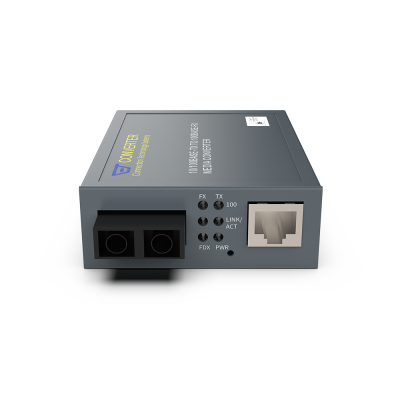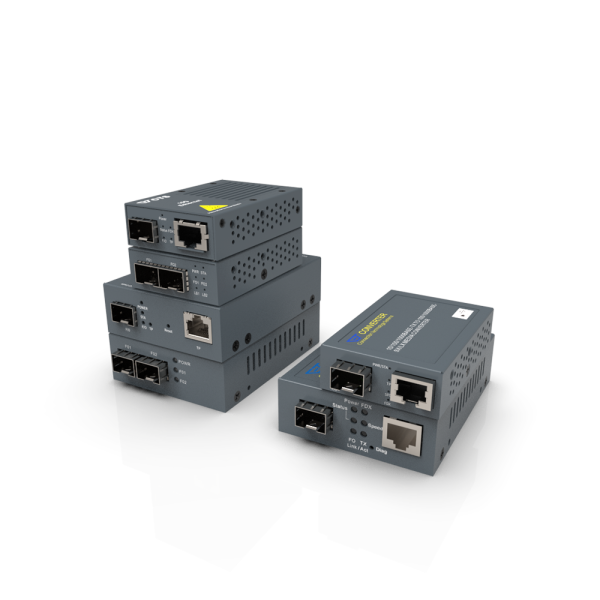▎Where CTS’s Journey Began: Media Conversion
Based in Taiwan, CTS embarked on our journey in 1998 with a simple yet revolutionary device: media converter, laying the foundation for our future innovations.
Since the inception of the internet, media converters have been essential to network connectivity. Acting as vital tools, these devices connect different types of network media — most commonly between copper-based Ethernet & fiber optic networks— enabling seamless data transmission across various infrastructure. By extending network reach, increasing data speeds, and reducing latency, media converters have become increasingly indispensable components of modern P2P networking.
Just as these devices exist between optical and electrical signals, at the turn between the 20th and the 21st century, CTS made its debut with the CVT-10BTF and CVT-110BTF in 1998 in Austria and other European markets. They offer single-speed signal conversion for 10BASE-FL to 10BASE-T, and 100BASE-TX to 100BASE-FX, respectively.
This development aimed to respond to the global demand of the 10Mbps mainstream broadband speeds, as well as the emerging 100Mbps (Fast Ethernet) broadband speeds, driven by the spread of office computers, large file transfers, and e-mail technology, which began to gain traction in the late 1990s, in developed markets like Europe, Northern America and Japan at that time.
▎A Mega Leap in Connectivity: The World’s First Dual-Speed Media Converter
“Innovation to Your Needs” has been at the core all along CTS’s journey. A turning point arrived in 1999 with the launch of CTS’s CVT-100 (see Figure 1), the world’s first 10/100Mbps switching media converter. By enabling flexible conversions between 100Mbps fiber and 10/100Mbps Ethernet, CTS addressed a significant limitation of single-speed converters, which could only handle specific data rates, such as 10Mbps fiber to Ethernet.

Figure 1: CTS’s CVT-100, Launched in 1999
In support of two speed rates, the CVT-100 helped simplify network design for system integrators, and paved the way for more scalable and adaptable networks by allowing legacy devices (eg., an installed CVT-100) to coexist with newer, faster end equipment (eg., a 100M modem).
In terms of cost, compared to installing single-speed media converters, the introduction of the CVT-100 significantly reduced upgrade overall expenses for network administrators, such as cabling design, new equipment procurement, and labour-intensive upgrades and replacements, especially in developed countries where labour costs are relatively high. Given the long lifespan (5-10 years) of CTS products, the CVT-100 proved to be a cost-effective solution, helping users save over 50% on their total cost of ownership (TCO) compared to using single-speed media converters, particularly during the period of 100Mbps dominance from the late 1990s to the mid-2010s. Until now, the CVT-100 has been standing out as a popular choice for network administrators seeking to build more scalable and cost-effective networks in the long run.
With these groundbreaking features, the CVT-100 quickly gained huge recognition in Japan’s FTTx market in cooperation with a Japanese major electricity provider at the dawn of the new millennium (2000s). Moving ahead, CTS continued to innovate, launching in-band managed media converters and switches, gateways, and more networking products for this ever-evolving digital era.

Figure 2: CTS’s Media Converters─ MCT & CVT Series
▎A Global Impact: CTS Media Converters Powering Networks Worldwide
Today, CTS’s media converters are deployed in over 40 countries, serving industries across the spectrum, from industrial and commercial to residential sectors. What began as a simple copper-to-fiber conversion solution has evolved into a comprehensive network solution supporting speeds from 100Mbps, 1Gbps, and up to 10Gbps, meeting the growing demand for high-speed, widespread network coverage. CTS’s media converters can be found in diverse environments, including factories, outdoor infrastructures, campuses, commercial complexes, residential settings, and more.
👉 For more details about cases of CTS’s media converters, please check out: p.2-p.3 of CTS’s October Newsletter 2024
In an increasingly interconnected world, media converters remain a vital cornerstone of global digital infrastructure. In today’s increasingly interconnected world, media converters remain a vital cornerstone of global digital infrastructure. At CTS, we are steadfast in our commitment to advancing this foundational technology, ensuring its evolution and impact extend well into the 21st century and beyond.
